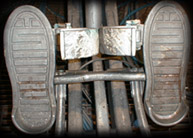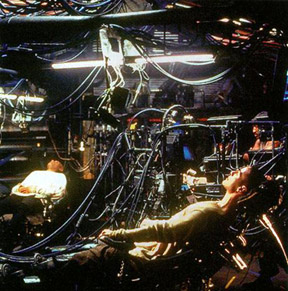
 Archival interview with Trevor Smith from the official Matrix website.
Archival interview with Trevor Smith from the official Matrix website.
MATRIX: What was your role in ‘The Matrix’?
TREVOR: I am a model maker. I worked on everything from prototypes to miniatures and props, mechanical props, molds and prosthetic pieces. The list is endless. As model makers, we use lathes, we are machinists, low voltage electricians and we have pneumatic and hydraulic skills. We also do miniatures, and some of us have architectural backgrounds, so we do a lot of architectural miniatures. Paint effects as well: we can paint cars or anything that is needed. Basically, there is nothing that we don’t get asked to do. We can be asked to make a car, which must work, but must also be a miniature.
MATRIX: How big was the model making crew?
TREVOR: There were 35 of us at one point. It is really hard to keep tabs on everybody running around. Everyone is divided up into teams, but there is not that much experience throughout each team, so Tom Davies and I have been working with everyone. We managed to pull it off in the end, but next time we will know a lot better, we’ll know what we have to do.
MATRIX: Have you worked in films before?
TREVOR: Yeah, but ‘The Matrix’ is the biggest. I have worked on ‘Thin Red Line’, ‘Oscar and Lucinda’ and ‘Dark City’ amongst other films and commercials. Each film – arty, sci-fi, romantic – needs model making in a very specialized area. But this one calls on all your skills at every point in time.
MATRIX: More than ‘Dark City’?
TREVOR: Very much so. ‘Dark City’ was a very small budget movie compared to this project. There was a lot of mass production on ‘Dark City’, for city scapes, miniatures and a few props. Whereas with this, the props are all real, they all work… the Nebuchadnezzar, the pods… and it goes on from there.
MATRIX: There is so much here that has impressed me, particularly the chairs in the Nebuchadnezzar.
TREVOR: There was a lot of work in that. That job started out with Geof Darrow’s illustrations, from there we went to the computer, then we had to run through the processes and prototyping. Basically, the model-making department is given the job of making the prototype. So we made a timber pattern for a chair, put it together, and the directors looked at it. It was then reprocessed for a few little tweaks and things that they wanted us to play around with. There were about four or five prototypes before we actually got around to expediting the chairs that were used. The aesthetic department took over from the model department at one point, then the chairs were sent away to get cast into aluminum, then to get machined… it was a huge process.
MATRIX: You were saying that there were a number of prototypes of the chairs. Were any of the others machined?
TREVOR: Yeah, some of them were. We also had a timber prototype. When the chairs were made we had no cushions, they hadn’t been designed, so visually it was doing what we wanted it to do, but to put a 5 foot one person into it and then put a 6 foot 3 person into it created some problems. The prototype was never quite right. Everyone was saying we should have used a dentist’s chair, but it wouldn’t have been the same.
MATRIX: It has the elements of a dental chair, but with so much more.
TREVOR: Yeah. Hydraulics, pneumatics, and the design. It is a future piece. A dental chair is something that has been made, been done already. People have put money into this movie and they want to see a return on it, hopefully that set will sell the movie. People will start to believe in the concept, in the pods and everything else, the kung fu, dropping out and being picked up by cables…it just over powers you completely. We have high hopes for this movie – that it is going to be a big one. It has been great working on it. I have been working on this since November (1997). So its about time for a little holiday as well.
MATRIX: Did you work on the bug extractor?
TREVOR: No, Simon Parker worked on that. Another machining feat. Basically, we are given someone’s sketches – a little picture – and that is when the model department takes over. We are used to prototyping, to seeing two dimensional drawings and turning them into three dimensional objects, coordinating with other departments such as prosthetics. In the model department we work out the limitations of what each design can do, working through every process, deciding what is possible and what is not. A piece like that didn’t have as much air time as it should have. I think that bug extractor cost about $40 000 to build, not counting all the extra hours that were put in by Simon. But he loves what he does – we all do – although we don’t always get the recognition for it. We are given wonderful opportunities to make things like that. The bug extractor was amazing in that it was a mixture of completely hand made pneumatics – all the pistons, all the valves, all the switching mechanisms, all the handles, the lighting shells – everything was achieved by hand from one solid lump of aluminum. People have no idea the amount of thought and work that goes into these designs… they wonder where we have bought this bug extractor from, if we have gone to a special surgical shop and bought it. But it has come from a drawing and a lump of aluminum. The syringes as well, in fact most of the stuff that we do. It is a bit of a shock if you come into a project like this from a commercial area, or from a couple of low budget movies. When you start this job they say 8 to 10 weeks and it turns out to be 90… a big learning curve for us, although I have done similar work in London, I know what it is like working on big budget movies.
MATRIX: The pods, for example, are incredible.
TREVOR: That was a feat in itself. We had to make to the master, sculpt it all out and foam and fiber glass it, then send it out to be vacuum formed in 10 ml acrylic. That is a one off. It was a first for us here to actually visualize water being held in 10 ml perspex. It was just perspex, nothing special, we had a few leaks, but it held together. I think the visual concept of it all is just amazing. People won’t pick things, they will just see it all and get blown away. This is one of those movies that you just have to sit back, you’re in for a ride for the next couple of hours.
 MATRIX: What was your favorite piece that you worked on?
MATRIX: What was your favorite piece that you worked on?
TREVOR: The Nebuchadnezzar. I worked on the chairs from the first day that I started till it wrapped. I worked on them for three weeks solid during shooting as well. So to actually see that come to fruition was just amazing. I was responsible for 60% of the whole of that coming together. To be involved in such a big way, and have it work, then filmed, and everyone loving it, just blows you away.
MATRIX: That set did blow a lot of people away.
TREVOR: And it just got better. There was so much more that they could have done. It is the same with the cock-pit. They shot the cock-pit for a day and it took months to build – everything was all hand made – all the seats, pneumatic sliders, controls. And then after a day it is all gone, it is out there in the shed being dismantled right now. It is incredible.
MATRIX: What happens to all the parts?
TREVOR: Rumor has it that they are being sent up to Warner Bros. to put up on a display.
MATRIX: Here in Australia?
TREVOR: Yes. Rebuilding that would be just as hard as putting it together the first time, if someone doesn’t know how it goes together. They’re not going to get us up there to do it again – once is enough!
MATRIX: It came down a lot quicker than it went up.
TREVOR: Yeah, that’s the way it is. We tear down forests and we can just throw them all in the garbage bin, and its just… “See ya later”. The film industry is very disposable.
MATRIX: I’ve seen the giant garbage bins all around the back lot. If I lived in Australia I’d be grabbing this raw material – better than a lumber-yard.
TREVOR: It is funny you should say that. There are a couple of people I know who have decked out their whole houses with old sets and pieces of furniture. Apparently they look incredible, fake marble and granite pieces. You would never know none of it’s real. You don’t know when you see it on film, you don’t even know when you’re on set. And I’m not going to say I’ve never done anything like that. I’ve a few bits of memorabilia at home.
MATRIX: How did you first get involved with ‘The Matrix’?
TREVOR: Before this, I worked on ‘Dark City’ with Tom Davies who is the miniatures and models supervisor on ‘The Matrix’. He had said that on his next job he would ensure that I was leading hand, working with a team. So as soon as this movie came up, I was one of the first people on. My CV [resume] is in a lot of people’s pockets, but it is the luck of the draw really. You never know what project will be up next. It depends who is doing it and how big the budget is. If you get an opportunity on a small movie, then you can work up. So I got this job through Tom, we set up in Mascot, then came here, and for me, that was just wonderful.
MATRIX: Did you take to the script when you first read it?
TREVOR: Yeah. The script of ‘The Matrix’ is very fast, like the movie is very fast. Everything happens so quickly. You are given all this information and it jumps backwards and forwards from reality to make believe, so the film just flies through. The script is very good reading, but as you watch the film unfolding during shooting you understand the script a lot more. In the script you don’t understand what goes on behind, there are no little brackets that fill you in to every scene. As the pod comes together with everything else – it all just clicks – and you understand why you have made all this stuff, why you have spent so much time on this. The amount of work that has gone into everything has been equal.
MATRIX: Thanks Trevor.
Interview by Spencer Lamm

Be the first to comment